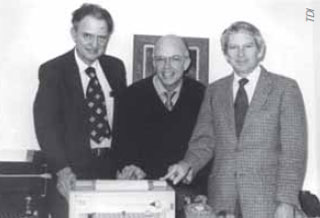|
Before instant messaging via computer, or
texting on mobile phones, people with hearing
impairments relied on a device called the
teletypewriter, or TTY, connected to a phone.
| |
 |
| Photo
credit: TDI |
| Robert
H. Weitbrecht, James C. Marsters and Andrew
Saks broke the telephone barrier for the deaf
in 1964 when they converted an old, bulky,
clacking Teletype machine into a device that
could relay a typewritten conversation through
a telephone line. It was the first example of
what became commonly known as a TTY. |
In the 1960s and 1970s, some pioneering deaf people
in the United States developed relay services to
enable deaf and hearing people to communicate with
each other. “A Phone of Our Own: The Deaf
Insurrection Against Ma Bell” chronicles an
important leap forward in the progress of deaf
communication from the 1960s to the 1990s. Written by
Harry G. Lang, Professor at the Department of Research
in the National Technical Institute for the Deaf, and
published in 2000, the book highlights the role of
three enterprising men in the quest for telephone
access for the deaf community.
In 1964, Robert H. Weitbrecht (1920–1983), James
C. Marsters (1924–2009), and Andrew Saks
(1917–1989) started the process that would lead to
deaf people around the world having an affordable
phone system that they could use. All three were deaf.
They also were independent and believed that deaf
people could and should help themselves instead of
relying on hearing people.
Andrew Saks was deafened by a mastoid infection in
his infancy. Grandson of the founder of Saks Fifth
Avenue, a department store in New York City, Saks
studied electrical engineering at the University of
California at Los Angeles. He tinkered with visual
communication devices that would assist deaf people,
working on relay coils and flashing light signallers
to let him and his friends know that the telephone was
ringing or that someone was at the door. He even set
up a private relay service for himself in California.
Once, while staying at a hotel in New York, he and his
wife were able to use that service to order breakfast
in their room. He also worked on an early version of a
signaller that would allow deaf parents to know a baby
was crying.
Robert Weitbrecht, who was born deaf and grew up to
become a successful physicist with the Stanford
Research Institute and a licensed amateur radio
operator, had been experimenting with a teletypewriter
(TTY) connected to his short-wave radio. He became
particularly interested in using Morse code to
communicate with other radio hams around the world. He
had obtained his used “receive only”
teletypewriter from a Los Angeles newspaper plant in
1950. He was able to modify it so that it could also
send messages by radio. Hiking up Lassen Peak, he met
a man with a deaf son and struck up a friendship. The
man invited him to a dinner party, and one of the
guests put him in touch with James Marsters, a
prominent orthodontist and a licensed pilot, who had
been rendered deaf by scarlet fever in infancy.
Marsters communicated with his hearing patients by
reading their lips. “When this was not possible, his
dental assistant repeated their words. Like other deaf
people, Marsters found ways around most communication
barriers, but he had never found an adequate solution
to the problem of telephone access, despite more than
two decades of searching for a way to use the common
household telephone. When he learned of Weitbrecht’s
electronics background, he felt that destiny had
brought them together,” says Harry Lang in A Phone
of Our Own, Chapter One: “A Chance Encounter”.
Marsters had been experimenting with sound
amplification in order to solve the problem of how to
enable a deaf person to use the telephone. Marsters
flew himself to San Francisco to visit Weitbrecht at
home. When he saw Weitbrecht’s TTY connected to a
private telephone line, he immediately realized that
it offered the solution to the problem of how to give
deaf people independent access to telecommunications.
| A
TTY is a special device that lets people who
are deaf, hard of hearing, or speech-impaired
use the telephone to communicate, by allowing
them to type messages back and forth to one
another. A TTY is required at both ends of the
conversation in order to communicate. |
|
When Marsters returned home, he bought a used
Western Union TTY and continued to encourage
Weitbrecht to carry on his experiments.
Marsters introduced Weitbrecht to Saks, who brought
his business experience to the group, and the three
men soon set to work. They started by collecting and
reconditioning Teletype machines discarded by news
services and companies such as Western Union.
Weitbrecht developed the telephone acoustic coupler
(now known as a modem) and came up with the idea of
using it to connect two Teletype machines. The coupler
changed electrical signals from one machine into
tones, which were then changed back into electrical
signals at the other machine so the message could be
printed.
“Are you printing now?” Weitbrecht asked Dr
Marsters during their first successful transmission
between their California homes in Redwood City and
Pasadena over a traditional telephone line. “Let’s
quit for now and gloat over the success.”
The three men later formed their own research and
development company: Applied Communications (APCOM),
Inc. APCOM’s main aim was to develop practical
telecommunication equipment for use by deaf people.
The three partners invested their own money in the
company and marketed the “Phonetype” modem, as
Weitbrecht’s acoustic telephone coupler was known.
Marsters embarked on a nationwide tour as the
company’s spokesperson, praising the TTY’s
effectiveness and stressing the need for everyday
safety. He urged deaf people, hospitals and fire
departments to install the machines for emergency
calls.
Paul Taylor, a deaf engineer and associate
professor at the Applied Computer Technology
Department in the National Technical Institute for the
Deaf, formed the first local advocacy group in St
Louis, Missouri in 1968, to collect, overhaul and
distribute teleprinters to deaf families. He is also
known for his advocacy for a nationwide
telecommunications relay service. The use of
refurbished teleprinters sparked the development of
text telephones and eventually a text relay service..
|

